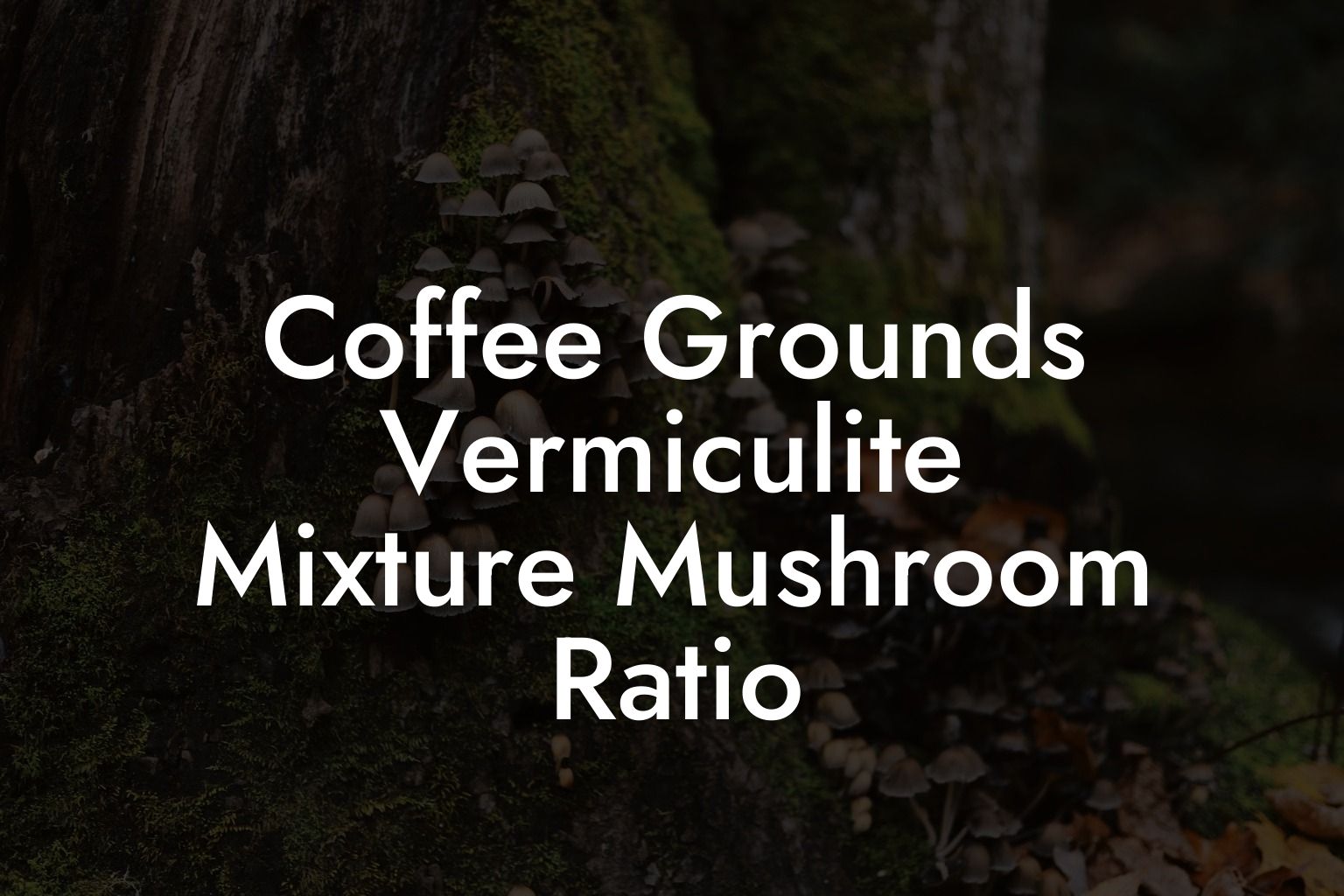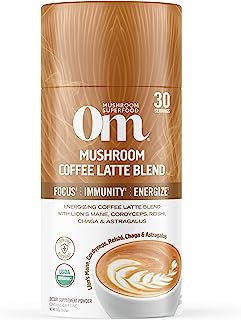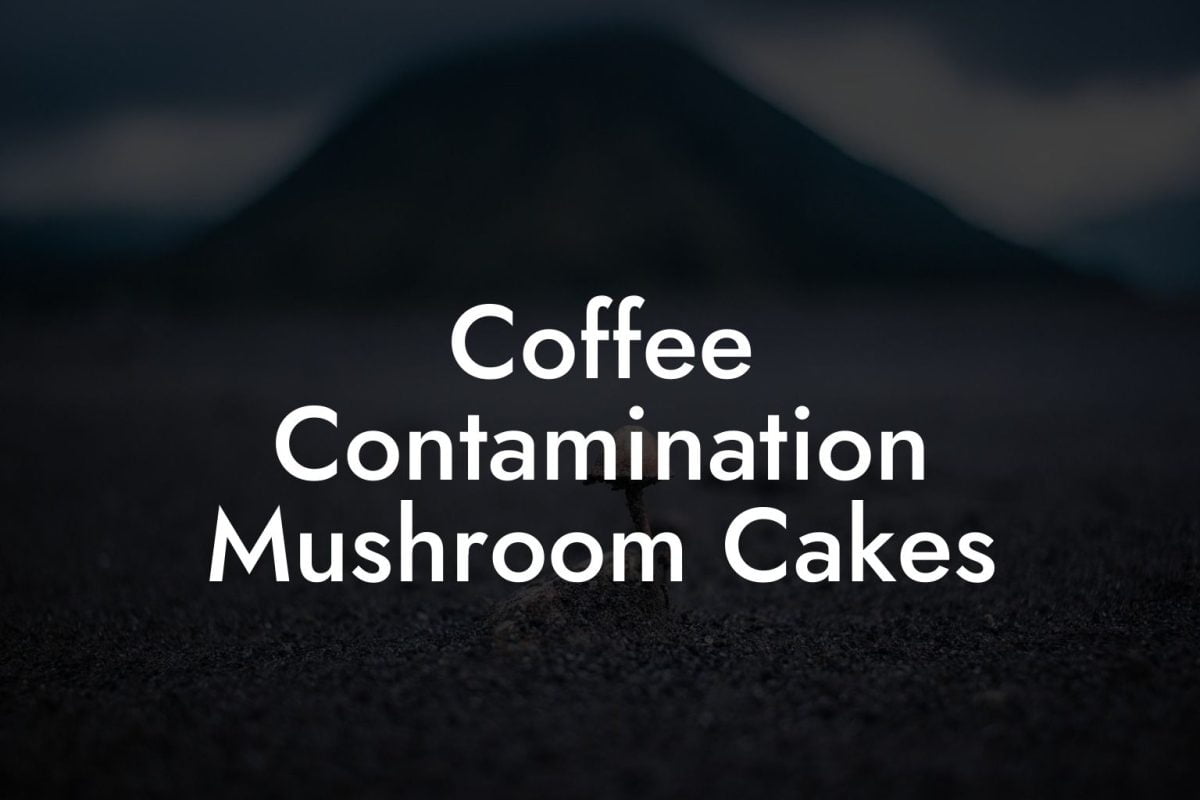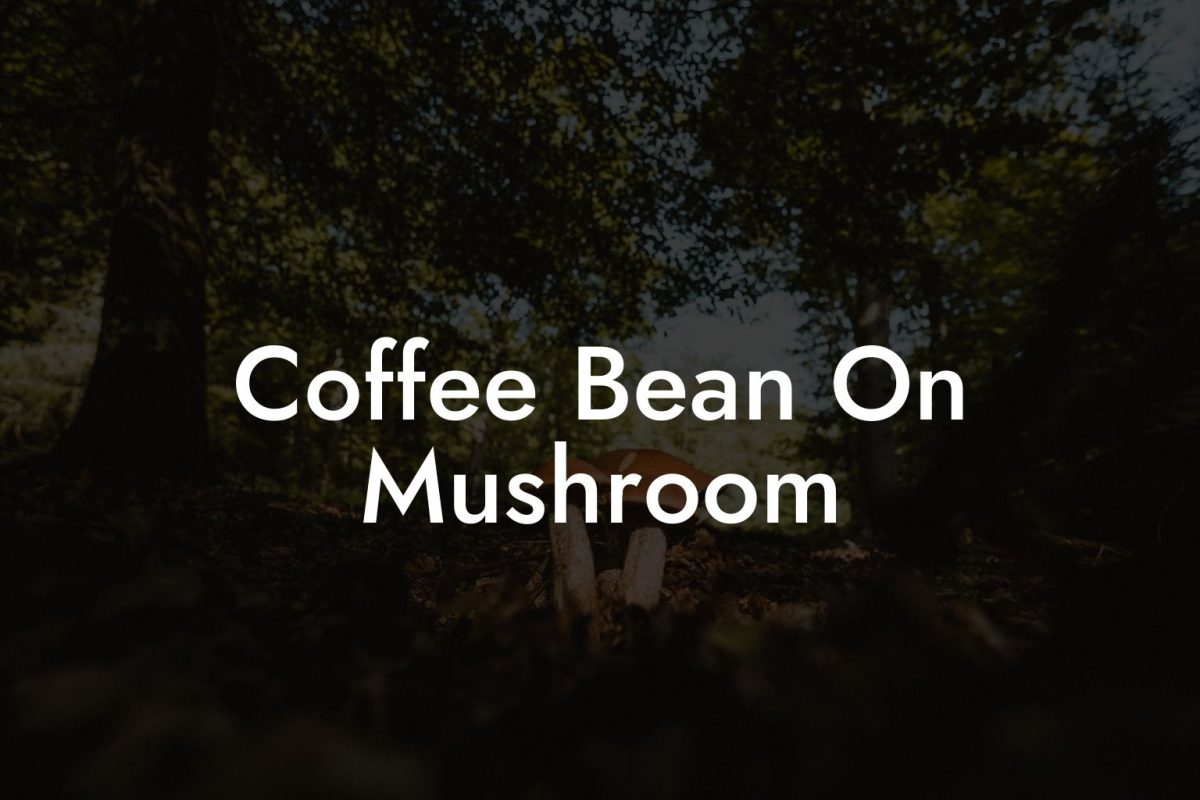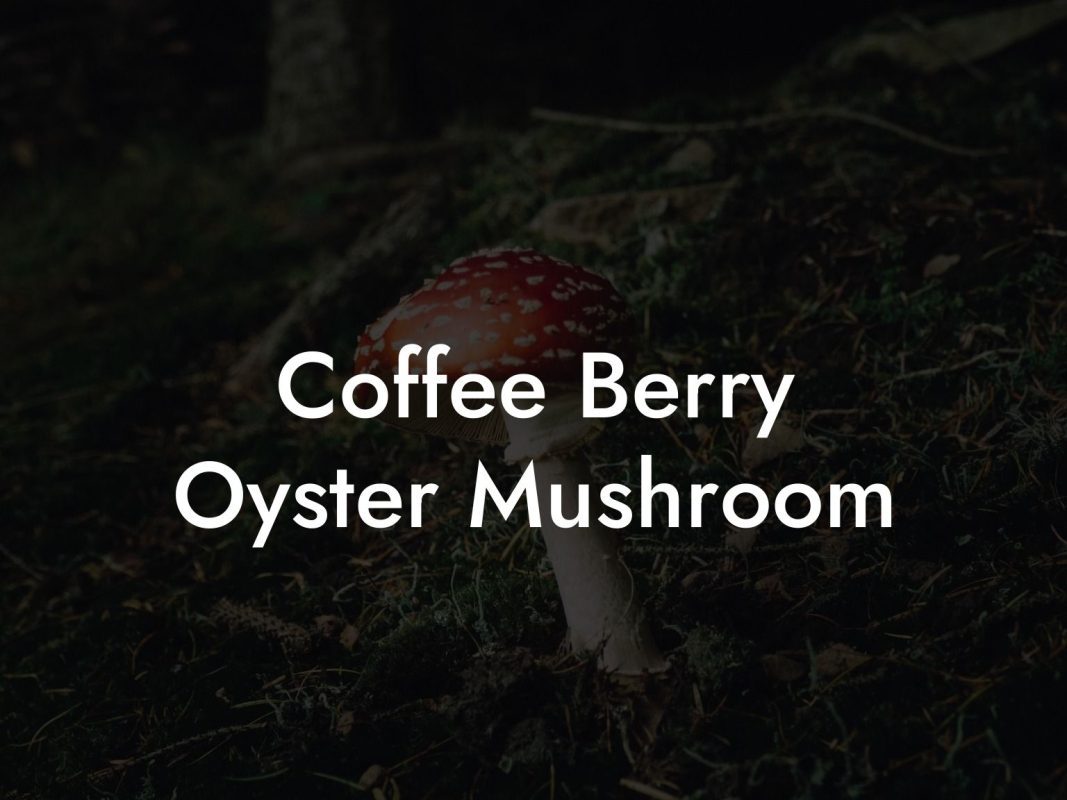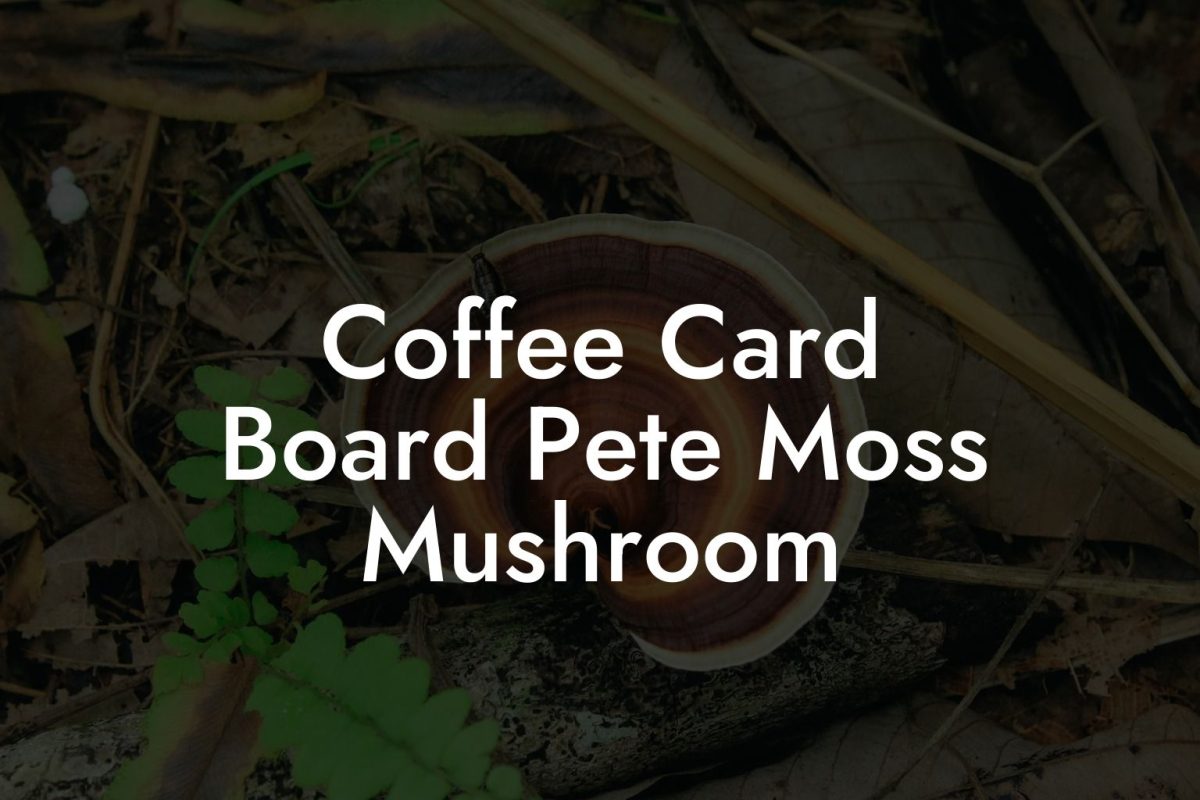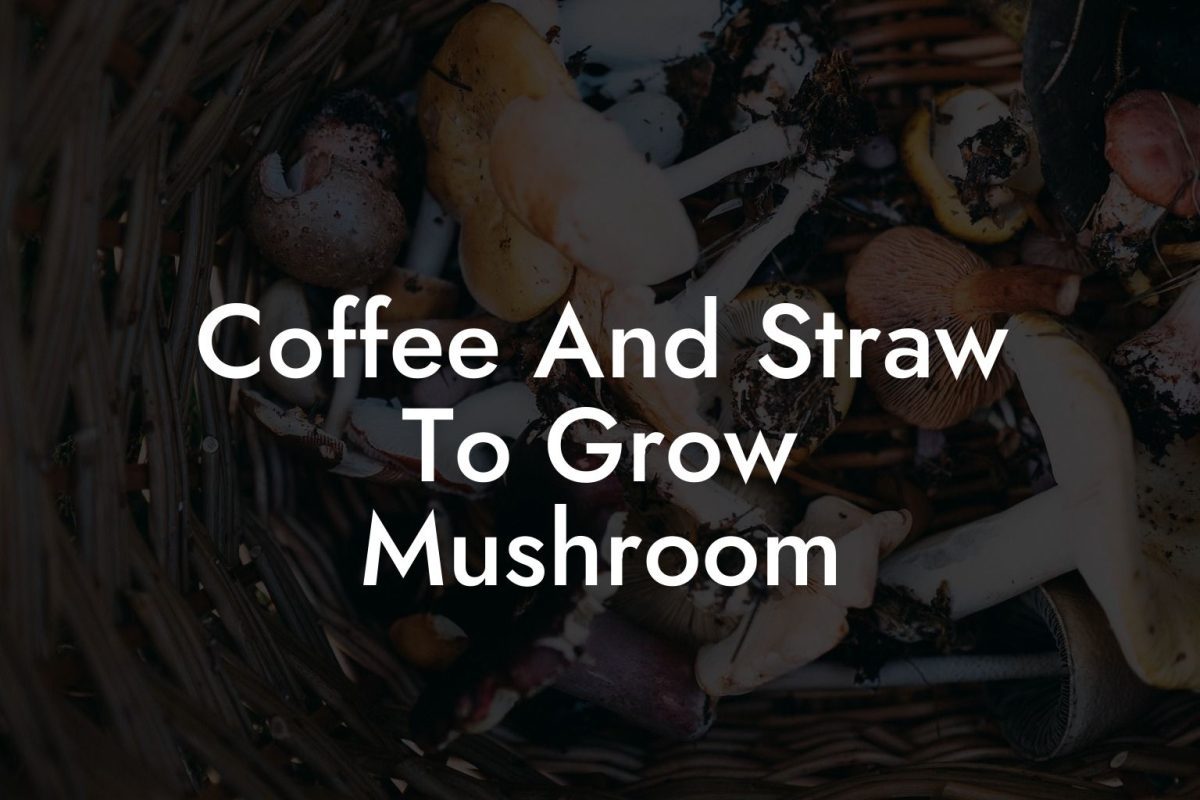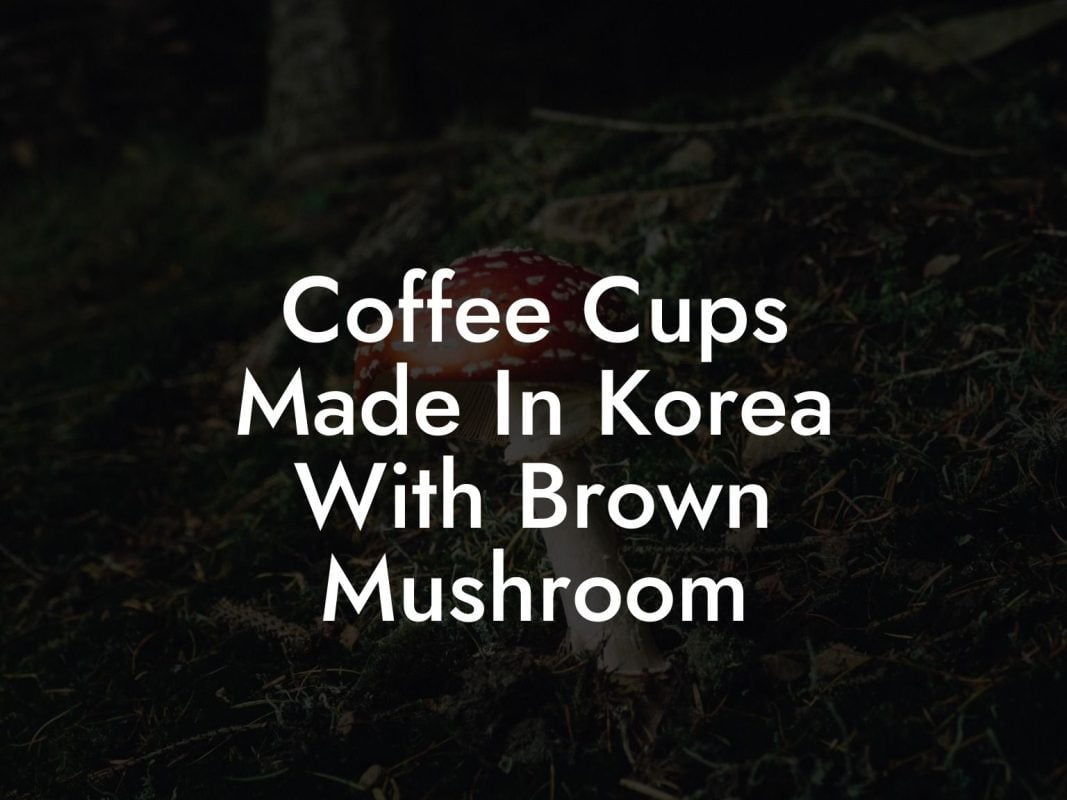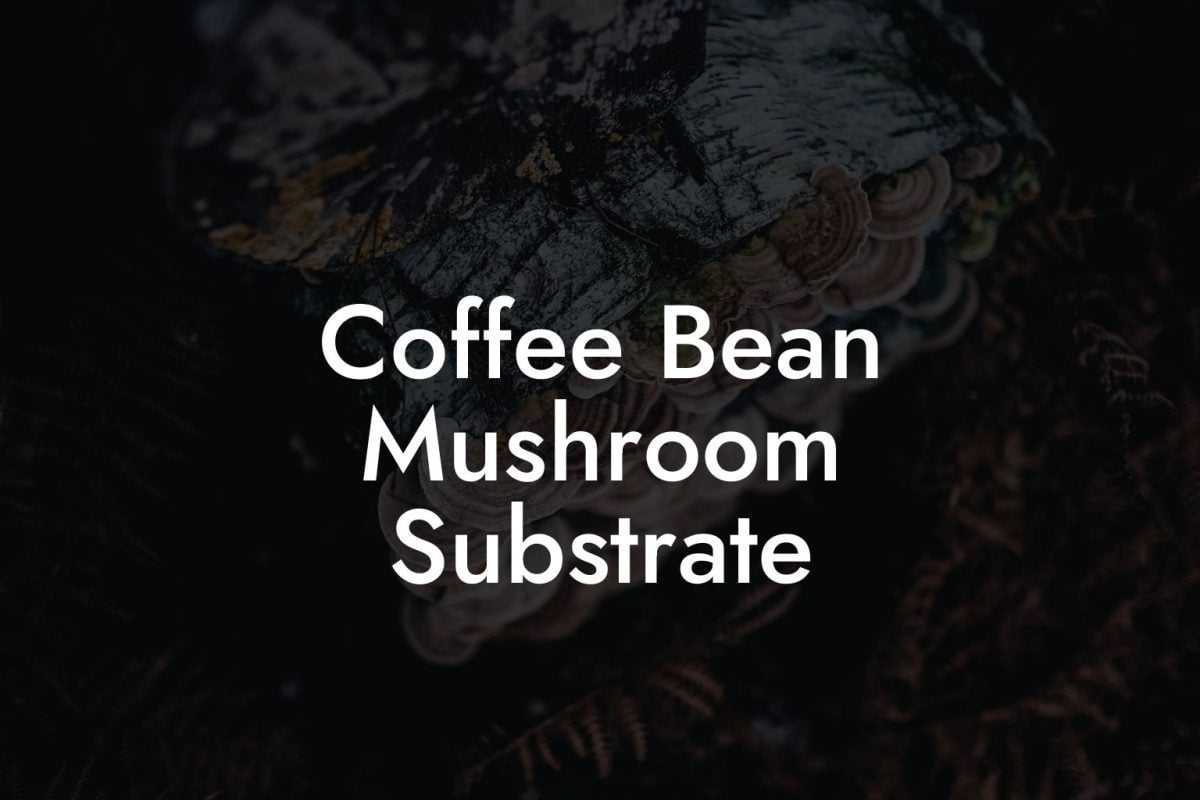Ever wondered how to level up your mushroom cultivation game while keeping it eco-friendly and quirky? Welcome to the world of the Coffee Grounds Vermiculite Mixture Mushroom Ratio, your new secret weapon in the art and science of growing those funky, nutrient-packed mushrooms that are taking over your Instagram feed (and your coffee routine). If you’re a Gen-Z or millennial trailblazer with a taste for both gourmet coffee and gourmet fungi, this guide is your one-stop resource for mastering the perfect blend of coffee grounds, vermiculite, and mushrooms. Get ready to brew up a storm in your DIY growing space!
Quick Links to Useful Sections
- What Is the Coffee Grounds Vermiculite Mixture Mushroom Ratio All About?
- The Science Behind Coffee Grounds in Mushroom Cultivation
- Why Vermiculite Is the Unsung Hero of Your Mushroom Substrate
- Breaking Down the Perfect Ratio: Coffee Grounds, Vermiculite, and Mushrooms
- Mixing It Up: Step-by-Step Guide to Preparing Your Substrate
- Step 1: Gather Your Materials
- Step 2: Sterilize Your Workspace
- Step 3: Measure and Mix
- Step 4: Adjust the Moisture Content
- Step 5: Inoculation Time
- Common Challenges and How to Overcome Them
- 1. Contamination
- 2. Inconsistent Colonization
- 3. Overly Dense Substrate
- 4. Poor Fruiting
- Integrating the Coffee Grounds Vermiculite Mixture in Mushroom Coffee
- Expert Tips for Maximizing Your Mushroom Yield
- Environmental Impact and Sustainability Benefits
- Mushroom Cultivation Trends: From DIY to Commercial Ventures
- Comparing Different Substrate Ratios: What Works Best?
- High Coffee Grounds Ratio (e.g., 1.5:1)
- High Vermiculite Ratio (e.g., 1:1.5)
- Balanced Adjustments
- Resources and Community Support: Your Next Steps
- Integrating Creativity into Your Mushroom Cultivation Process
- The Future of Mushroom Cultivation and Coffee Innovations
- Merging Science and Sustainability: Final Insights on Your Mushroom Journey
- Frequently Asked Questions on Coffee Grounds Vermiculite Mixture and Mushroom Ratios
- Your Next Step: Embrace the Journey of Sustainable Cultivation
What Is the Coffee Grounds Vermiculite Mixture Mushroom Ratio All About?
Picture your favorite cup of joe, but instead of fueling your morning hustle, its coffee grounds are giving life to a vibrant world of mushrooms! The Coffee Grounds Vermiculite Mixture Mushroom Ratio refers to the ideal proportion of used coffee grounds to vermiculite (a lightweight mineral that helps retain moisture) used as a substrate for mushroom cultivation. This mixture isn’t just about recycling old coffee; it’s a meticulously calculated formula that optimizes the nutrient profile, moisture retention, and aeration needed for mushroom mycelium to thrive.
In this guide, we’ll dive into the science and art behind creating this dynamic mixture, share tips to experiment with different ratios, and reveal some insider hacks that will make your mushroom cultivation journey as exciting as your morning latte. Whether you’re a mushroom newbie or a seasoned cultivator, understanding this ratio is the first step towards turning your kitchen waste into a blooming (or rather, fruiting) masterpiece.
The Science Behind Coffee Grounds in Mushroom Cultivation
Coffee grounds are more than just a post-brew residue, they’re a treasure trove of nutrients that can supercharge your mushroom substrate. When you use coffee grounds, you're essentially providing a rich, organic medium that’s loaded with nitrogen, which is critical for the growth of mycelium. Not only do these grounds offer essential micronutrients such as potassium, phosphorus, and magnesium, but they also create an acidic environment that discourages the growth of unwanted bacteria.
The beauty of coffee grounds lies in their dual role: they are both a food source and a soil conditioner. Their fine texture and optimal pH level make them a favorite among mushrooms like oyster, shiitake, and lion’s mane, which have delicate requirements. Plus, reusing coffee grounds is an eco-friendly practice, reducing waste and giving your mushrooms the best start in life.
Looking For The Best Mushroom Coffee? You'll Love These:
However, as fantastic as they are, coffee grounds alone are not enough. Enter vermiculite, a multi-functional amendment that transforms your substrate into a powerhouse of moisture retention and aeration.
Why Vermiculite Is the Unsung Hero of Your Mushroom Substrate
Vermiculite might sound like a mouthful, but it’s a mineral with a superpower: it expands when heated and can hold a surprising amount of water while maintaining a light, airy structure. In mushroom cultivation, this is gold. Vermiculite helps balance the density of the substrate, ensuring that your mushrooms aren’t smothered by an overly compact medium.
Think of it this way: while coffee grounds pack a nutrient-rich punch, they can also clump together and become too dense for optimal mycelial growth. Vermiculite mixes in to create spaces that allow mycelium to breathe and spread. It’s like adding that extra bit of "oomph" that turns a simple recipe into a gourmet dish.
The success of your mushroom cultivation process hinges on finding the right balance between these two components. Too many coffee grounds and you risk microbial invasion due to excess moisture and density; too much vermiculite, and you might dilute the nutrient content your fungi crave.
Breaking Down the Perfect Ratio: Coffee Grounds, Vermiculite, and Mushrooms
Now that we’ve laid the groundwork with the benefits of coffee grounds and the cool features of vermiculite, it’s time to get down to brass tacks: what is the ideal Coffee Grounds Vermiculite Mixture Mushroom Ratio?
While there isn’t a one-size-fits-all answer (much like your favorite spoonful of almond milk in that oat latte), a widely recommended starting point in many DIY mushroom cultivation guides is a ratio of approximately 1:1 by volume for coffee grounds and vermiculite. This means if you’ve got one cup of used coffee grounds, you’ll mix in about one cup of vermiculite. This simple mix creates a balanced medium that provides both nutrition and structure.
But wait, there’s more! The optimal ratio can vary depending on:
- Mushroom Species: Different species have different substrate needs. For instance, oyster mushrooms might thrive with a slightly higher percentage of coffee grounds due to their robust nature, whereas more delicate varieties may prefer a little extra vermiculite to ensure gentle moisture levels.
- Moisture Content: Since coffee grounds retain moisture, adjusting the amount of vermiculite can help fine-tune the water content. A drier mix might introduce more vermiculite to boost water retention without oversaturating the substrate.
- Environmental Factors: Temperature and ambient humidity play a role in how quickly moisture evaporates. During drier seasons, leaning towards a higher proportion of vermiculite might keep your substrate from drying out too quickly.
Experimentation is key! Use the 1:1 ratio as your launch pad and document the growth performance of your mushrooms. Track the speed of mycelium colonization, the density of the fruiting bodies, and any signs of contamination. Fine-tuning the ratio could mean the difference between a thriving patch of mushrooms and a disappointing batch.
Here’s an insider tip: sometimes, a small tweak, such as adding a splash of water or mixing in a bit of straw, can shift the balance and significantly affect your yields. It’s all about finding your perfect ecosystem.
Mixing It Up: Step-by-Step Guide to Preparing Your Substrate
Ready to get your hands dirty (in the best way possible)? Follow these downright fun steps to prepare your coffee grounds vermiculite mixture for mushroom cultivation:
Step 1: Gather Your Materials
Make sure you have:
- Used coffee grounds (preferably from organic coffee to avoid chemicals)
- Vermiculite (available at garden centers or online stores)
- A large mixing bowl (bonus points if it has a retro vibe)
- A clean spray bottle (filled with distilled water for best results)
- Gloves and a mask (for that hygienic and hip DIY look)
Step 2: Sterilize Your Workspace
Contamination is the arch-nemesis of mycelium. Disinfect your work area with a mixture of water and bleach (or a natural alternative for our eco-warriors) to create a bug-free zone where your fungi can flourish.
Step 3: Measure and Mix
Start by measuring equal parts coffee grounds and vermiculite. If you're testing the 1:1 ratio, combine one cup of coffee grounds with one cup of vermiculite in your mixing bowl. Stir the mixture thoroughly to ensure even distribution of both components.
Step 4: Adjust the Moisture Content
Now, lightly mist your mixture using the spray bottle. The substrate should have the consistency of a wrung-out sponge, not too wet, not too dry. A handy trick is to squeeze a handful of the mix: it should hold together without dripping water.
Step 5: Inoculation Time
Once your substrate is prepped, it’s time to introduce the star of the show, mushroom spawn. Gently mix the spawn into your substrate until evenly distributed, then transfer everything into your chosen fruiting container or bag.
With your substrate now ready, seal the container and wait for nature to work its magic. In a few days to a couple of weeks, you’ll start to see white mycelium spreading like a well-shared meme across your mix.
Common Challenges and How to Overcome Them
Like any great DIY project, venturing into mushroom cultivation with a coffee grounds and vermiculite mixture comes with its set of challenges. Here are some common issues and easy, down-to-earth solutions:
1. Contamination
Whether it’s mold or bacteria, contamination can derail your mushroom dreams. Always start with sterilized tools and workspace, and avoid over-saturating your substrate. Remember, a little prevention goes a long way.
2. Inconsistent Colonization
If your mycelium is growing erratically, it might be due to uneven moisture distribution or improper mixing. Stir the substrate gently if you notice dry patches, but be careful not to disturb the mycelium once it starts colonizing.
3. Overly Dense Substrate
Too many coffee grounds relative to vermiculite can create a compact environment that stifles growth. Experiment with subtle adjustments, if the 1:1 ratio feels too heavy, try a 1:1.2 (coffee grounds to vermiculite) mix to boost aeration.
4. Poor Fruiting
Even if mycelium colonization is successful, you might face challenges when it comes time for fruiting. This could be linked to factors like temperature, light, or humidity. Ensure your growing environment simulates the natural conditions required for your chosen mushroom species.
Troubleshooting is part of the adventure. Take notes, adjust your variables, and remember that each batch of mushrooms is a new experiment in discovering your perfect formula.
Integrating the Coffee Grounds Vermiculite Mixture in Mushroom Coffee
You might be thinking, “What does mushroom coffee have to do with all of this?” Well, mushroom coffee is the trendy lovechild of coffee and functional mushrooms, merging the rich flavor of coffee with the health-boosting properties of mushrooms. While the process of brewing mushroom coffee differs significantly from cultivating mushrooms, the underlying principles of using coffee grounds and optimizing ratios share a common theme: sustainability and efficiency.
In mushroom coffee production, certain functional mushrooms, such as chaga, reishi, and cordyceps, are harvested, dried, and added to coffee blends to create a unique beverage that promotes immune support, mental clarity, and overall well-being. While you’re busy cultivating your own mushrooms with the perfect coffee grounds vermiculite mixture at home, you’re also part of a larger movement that celebrates mindful consumption and sustainable living.
The cross-pollination between mushroom cultivation and mushroom coffee is more than a catchy marketing phrase, it’s a lifestyle. It’s about turning everyday ingredients into powerful, health-boosting elixirs that nourish both body and mind. So go ahead and savor that innovative fusion of flavor and function!
Expert Tips for Maximizing Your Mushroom Yield
Whether you’re an experimental first-timer or a seasoned cultivator, these expert tips will help you get the most out of your coffee grounds vermiculite mixture:
- Temperature and Humidity: Maintain an environment with stable temperatures (around 65°F to 75°F, depending on your mushroom species) and high humidity. A humidity dome or a small humidifier can help in maintaining optimal levels.
- Consistent Light: You don’t need bright sunlight; indirect, ambient light is preferable to support fruiting without causing overheating. Think of it as the diffused glow for your fungi’s Instagram shoot.
- Proper Air Exchange: Ensure that your growing space has adequate ventilation. Fresh air is vital for healthy mushroom growth, preventing the buildup of CO2 that could stunt your mycelium’s development.
- Maintenance of pH Levels: While coffee grounds have their natural acidity, periodically check the pH level of your substrate. Most mushrooms prefer a slightly acidic to neutral pH, so adjust with lime or other amendments as needed.
- Observation and Patience: Document every step of your process. Observe how subtle changes in the ratio affect the growth and fruiting pattern. Patience is as important as passion when cultivating mushrooms.
Experimentation is the name of the game. Each mistake teaches you something new, a tweak here, a little adjustment there, and soon you’ll be fine-tuning your setup like a pro barista perfecting an artisanal brew.
Environmental Impact and Sustainability Benefits
In today’s world, every sustainable choice counts. By repurposing used coffee grounds and integrating them with natural vermiculite, you’re reducing waste and promoting a circular economy. This ecological method doesn’t just benefit your mushroom yield, it contributes to a healthier planet.
Using upcycled coffee grounds means fewer waste products in landfills, and the nutrients they contain continue to serve a purpose in nature by feeding the mycelium. Vermiculite, which is naturally occurring, is a renewable resource that helps enhance the water retention and aeration of the substrate without the need for synthetic additives.
Engaging in sustainable practices also aligns perfectly with the values embraced by Gen-Z and millennials. It’s a win-win scenario: a luscious, reliable mushroom harvest and a clearer conscience knowing you’re doing your part for the environment.
Mushroom Cultivation Trends: From DIY to Commercial Ventures
Mushroom cultivation isn’t just a hobby, it’s a thriving industry. As more people discover the benefits of gourmet and medicinal mushrooms, trends in cultivation continue to evolve. Home growers are sharing their experiments on social media, while startups are capitalizing on eco-innovative practices that repurpose everyday materials.
The coffee grounds vermiculite mixture is the perfect example of how sustainability meets practicality. From tiny urban balconies to large-scale commercial farms, this organic substrate has become a popular choice due to its simplicity, affordability, and effectiveness. With influencers and DIY enthusiasts spreading the word on platforms like Instagram, TikTok, and Reddit, the mushroom culturing community is buzzing with tips, tutorials, and success stories.
Whether you’re planning to grow a few mushrooms for your morning brew or looking to explore commercial opportunities, understanding and perfecting the ratio of coffee grounds to vermiculite is a crucial first step. The potential for scalability is huge, what started as a humble kitchen experiment could well evolve into a revolutionary movement in sustainable agriculture.
Comparing Different Substrate Ratios: What Works Best?
While the 1:1 ratio is a tried-and-true starting point, many cultivators are curious about exploring variations to find their ultimate formula. Here are a few common ratio adjustments and their potential effects:
High Coffee Grounds Ratio (e.g., 1.5:1)
Increasing the coffee grounds compared to vermiculite boosts the nutrient content, which can be beneficial for aggressive mushroom strains that need a rich feeding ground. However, too high a concentration might lead to a denser substrate, limiting airflow and increasing the risk of contamination.
Use this variation for robust species like oyster mushrooms, but monitor moisture levels closely to avoid clumping and anaerobic pockets.
High Vermiculite Ratio (e.g., 1:1.5)
Leaning on vermiculite provides extra aeration and moisture retention. This formulation might be ideal for species that prefer a lighter, more airy medium. A substrate with more vermiculite tends to be less prone to bacterial contamination, but might slightly dilute nutrient density.
This ratio is particularly helpful in drier climates or during humid seasons when controlling water content is crucial.
Balanced Adjustments
Some enthusiasts experiment with ratios around 1:1, then add minor tweaks based on observation. Is your mycelium spreading too slowly or fruiting unpredictably? Small, incremental changes in your coffee grounds to vermiculite ratio can lead to significant improvements. Keep a journal of your experiments, and soon you’ll have a personalized recipe that caters perfectly to your environment and mushroom species.
The key is consistency and patience, each batch offers new insights and opportunities for refinement. Embrace the journey, celebrate your successes (and mishaps), and know that every experiment is a step toward cultivation perfection.
Resources and Community Support: Your Next Steps
Diving into mushroom cultivation, especially when exploring unconventional substrates like a coffee grounds vermiculite mixture, can feel like entering a new frontier. The good news? You’re not alone on this journey. Countless online communities, forums, and local groups are eager to share tips, troubleshoot problems, and celebrate breakthroughs with you.
Here are some resources to help you along the way:
- Online Forums: Websites like Shroomery and MycoWeb provide discussion boards where veteran cultivators and curious beginners trade stories and advice.
- Social Media Groups: Platforms like Reddit (r/MushroomGrowers, r/urbanmushrooms) and Facebook groups offer real-time discussions, photo-sharing, and step-by-step tutorials.
- DIY Blogs and YouTube Channels: There are many digital creators who document their experiments with coffee grounds substrates, from unboxing mushrooms to detailed how-to guides that are as entertaining as they are informative.
- Local Workshops and Classes: Look out for local agricultural co-ops, sustainable farming groups, or urban gardening workshops. These in-person events offer hands-on demonstrations and direct expert advice.
- Books and E-Resources: If you love a good read, several comprehensive guides delve into the nuances of mushroom cultivation, offering insights from both science and tradition.
Engaging with the broader community not only enhances your learning but also connects you with like-minded enthusiasts who share your passion for sustainability and innovation. So put on your digital explorer hat, join a group, share your progress, and don't be afraid to ask questions. The journey to mastering the perfect coffee grounds vermiculite mixture mushroom ratio is as much about the community as it is about the science.
Integrating Creativity into Your Mushroom Cultivation Process
Innovation is the secret ingredient that makes mushroom cultivation so much fun. From tweaking substrate ratios to exploring unique growing environments, the process can be as creative and experimental as graffiti art or indie music. Why settle for the ordinary when you can transform everyday kitchen waste into a flourishing ecosystem of fungi?
Here are some creative ideas to elevate your cultivation venture:
- Mushroom Art: Create mini ecosystems in decorative containers or repurposed mason jars. Experiment with layering different substrates and even playing with colors (think tinted coffee grounds) to add a visual twist.
- Feature Your Harvest: Share your progress on social media using hashtags like #MushroomMagic, #EcoCultivation, and #CoffeeFungi. Your innovative substrate recipe might just go viral among fellow eco-enthusiasts.
- Collaborative Projects: Why not team up with local coffee shops or community gardens to create demonstration projects or seasonal workshops? Sharing your passion can build a network of support and creativity.
- Sustainable Recipes: Once you’ve harvested your mushrooms, explore recipes that highlight their unique flavors. From gourmet dishes to mushroom-infused coffee brews, the culinary possibilities are endless.
Let your imagination run wild. The journey of refining your coffee grounds vermiculite mixture mushroom ratio is not just about cultivation, it's about creating a lifestyle that embodies sustainability, innovation, and a bit of rebellious fun.
The Future of Mushroom Cultivation and Coffee Innovations
As we progress further into an era defined by sustainability and eco-conscious living, the intersection of coffee culture and mushroom cultivation is poised for explosive innovation. Researchers, hobbyists, and commercial ventures alike are continuously exploring new ways to optimize substrate formulas, experiment with different fungal species, and maximize yields.
Consider the potential: imagine smart cultivation systems that automatically adjust moisture levels in your coffee grounds vermiculite substrate, or urban farms that repurpose local coffee waste for large-scale mushroom production. The future of this industry is shaped by a blend of technology, nature, and grassroots innovation.
Whether you’re simply experimenting in your kitchen or planning a commercial enterprise, embracing the beauty of natural cycles and sustainable practices is the key to success. Your small experiment might just spark a revolution in eco-friendly agriculture, one that prioritizes efficiency, creativity, and environmental stewardship.
Remember, every mushroom that sprouts from your carefully mixed substrate is a testament to the power of innovation, resourcefulness, and the unstoppable spirit of contemporary culture. Keep pushing the boundaries, stay curious, and most importantly, have fun while doing it!
Merging Science and Sustainability: Final Insights on Your Mushroom Journey
The Coffee Grounds Vermiculite Mixture Mushroom Ratio is more than just an experimental formula, it represents a harmonious blend of science, sustainability, and creativity. As you cultivate your mushrooms, you’re not only embarking on a practical venture but also joining a movement that values eco-consciousness and resourcefulness.
Every step you take, from gathering coffee grounds to adjusting the moisture and watching the mycelium weave its intricate tapestry, is a step towards a sustainable future. By merging waste materials with natural resources like vermiculite, you’re proving that innovation often sprouts from the simplest of ingredients.
Embrace the trial and error, celebrate the unexpected yields, and above all, keep your passion alive. Whether you’re here to create the perfect substrate for your fungi or to reinvent your morning ritual with a dash of mushroom coffee magic, your journey is a vibrant blend of art and science.
So, gear up, get mixing, and let each batch of mushrooms remind you that sustainability can be fun, bold, and utterly delicious. Your experiment might just inspire the next viral trend in eco-friendly innovation, and that’s a story worth sharing.
Frequently Asked Questions on Coffee Grounds Vermiculite Mixture and Mushroom Ratios
Curious to know more? We’ve compiled a list of frequently asked questions about creating the perfect coffee grounds vermiculite mixture for mushroom cultivation. Dive in to quench your curiosity!
1. What is the ideal ratio of coffee grounds to vermiculite for mushroom cultivation?
Most beginners start with a 1:1 ratio by volume, equal parts coffee grounds and vermiculite. However, the optimal ratio might shift based on the species of mushroom, ambient conditions, and moisture levels. It’s all about experimenting and fine-tuning to meet your specific growing needs.
2. Why are coffee grounds used in mushroom cultivation?
Coffee grounds are rich in nitrogen and other nutrients essential for mycelium growth. Their slightly acidic pH also helps ward off contaminants, making them an eco-friendly and efficient substrate component.
3. How does vermiculite improve the substrate for mushrooms?
Vermiculite retains moisture and enhances aeration within the substrate. It creates the perfect environment for mycelium to breathe and spread, preventing the substrate from becoming too compact.
4. Can I adjust the ratio if my mushrooms aren’t growing well?
Absolutely. If you notice issues like clumping, slow colonization, or poor fruiting, try adjusting the ratio. Increasing vermiculite can improve aeration, while a boost in coffee grounds can provide more nutrients. Every setup is unique, so don’t be afraid to experiment!
5. How long does it take for mushrooms to start colonizing the substrate?
Depending on the species and environmental conditions, mycelium might start colonizing within a few days to a couple of weeks. Patience and consistent care are key to a successful harvest.
6. Are there any safety precautions I should follow during substrate preparation?
Yes, always sterilize your tools and workspace to minimize the risk of contamination. Using gloves, masks, and clean equipment is highly recommended, particularly when mixing ingredients and handling mushroom spawn.
7. Can I use this mixture for all types of mushrooms?
While many edible mushrooms like oyster and shiitake thrive on coffee grounds substrates, some delicate species might require additional amendments. Research the specific needs of your chosen mushroom variety for best results.
8. Is it possible to reuse coffee grounds after brewing for mushroom cultivation?
Absolutely! In fact, recycling used coffee grounds is one of the most sustainable practices in mushroom cultivation. Just make sure they haven’t been contaminated with additives or chemicals.
9. How do I maintain the right moisture level in my substrate?
Aim for a consistency similar to a wrung-out sponge. Use a spray bottle to gently mist your mixture while monitoring the moisture level. Adjust with water or additional vermiculite as needed.
10. Where can I find more resources on sustainable mushroom cultivation?
Check out online forums, social media groups, and local workshops dedicated to mushroom growing. Websites like Shroomery, MycoWeb, and various YouTube channels offer a wealth of information and community support.
Your Next Step: Embrace the Journey of Sustainable Cultivation
Now that you’re armed with knowledge about the coffee grounds vermiculite mixture mushroom ratio, it’s time to dive into your own cultivation adventure. This isn’t just about growing mushrooms, it’s about exploring a sustainable lifestyle, reimagining everyday waste as an opportunity, and joining a vibrant community of innovators.
Embrace the trial-and-error, celebrate each breakthrough, and remember that every experiment is a step towards perfecting your craft. With the perfect blend of science, creativity, and sustainability, your journey will not only yield delicious mushrooms but also an eco-conscious lifestyle worth bragging about.
Get mixing, share your adventures online, and never stop experimenting. The future of sustainable agriculture is bright, and it starts right in your kitchen. Cheers to a healthier planet, a bolder mushroom harvest, and a life filled with eco-innovative fun!
Looking For The Best Mushroom Coffee? You'll Love These:
Useful Interruption: Dive deeper into the world of Mushroom Coffee with our most popular sections. If there is anything you think is missing or anything you would love for us to write about, just give us a shout.
- Mushroom Coffee Equipment & Product Reviews
- Mushroom Coffee Recipes & Creative Variations
- Mushroom Coffee Guides & Troubleshooting
- Mushroom Coffee Brewing & Preparation Techniques
- Model Rocket Advanced Rocketry & Innovations
- Mushroom Coffee Fundamentals
- Model Rocket Equipment Reviews & Digital Tools
- Mushroom Coffee Health Benefits & Wellness
- Mushroom Coffee Mycology & Scientific Insights
- Mushroom Coffee Community, Lifestyle & Engagement
I tried mushroom coffee this morning and told my friend, "This brew is spore-tacular!" He shot back, "Guess that's why it's such a cap-tivating way to kickstart your day!"

